by hankinslawrenceimages | Jul 8, 2008 | Flowers, Nelumbonaceae Family, Photo Locations, Washington DC

Lotus Pond (c) 2008 Patty Hankins
In addition to the sunflowers at McKee-Beshers Wildlife Management Area, another favorite summer flower photography opportunity in the Washington DC area is the Lotus Blossoms at Kenilworth Aquatic Gardens. I headed into DC yesterday morning to see if they were blooming yet – and much to my delight they are.

(c) 2008 Patty Hankins
Kenilworth Aquatic Gardens are part of the Kenilworth Park and Aquatic Gardens National Park in Washington, DC. Currently the gardens cover 12 acres of open ponds full of water lilies and lotuses, surrounded by the Kenilworth Marsh. The gardens were established in the late 1800’s when Walter Shaw added a few water lilies to a pond on land he had recently purchased. Eventually Shaw and later his daughter ran the gardens as a commercial enterprise. In 1938, Congress authorized money to purchase 8 acres of ponds rather than having the Corps of Engineers destroy them as part of the dredging of the Anacostia River.

Lotus Blossom II (c) 2007 Patty Hankins
Yesterday’s visit was my third trip to the Kenilworth Aquatic Gardens. Bill and I discovered the park last summer, visiting in both July and August. We were hoping to photograph the Victoria Water Lilies. We still haven’t seen them – they bloom in late summer/early fall. Instead we had a wonderful time photographing the lotus blossoms.
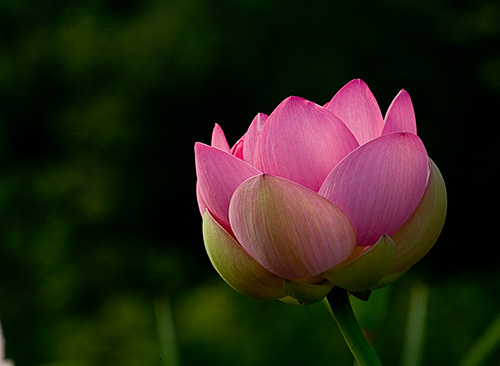
(c) 2008 Patty Hankins
The entrance to the gardens is located on 1550 Anascostia Ave NE in Washington DC. The park is open from 7 AM to 4 PM daily, except for Thanksgiving, Christmas and New Year’s Day. There is no admission fee charged to visit the gardens.
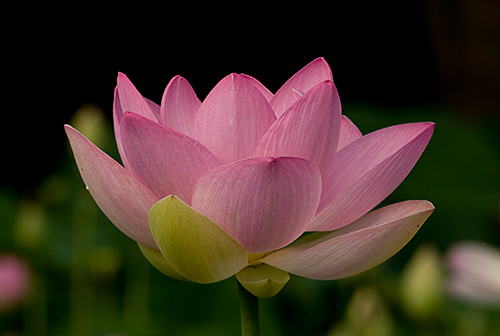
(c) 2008 Patty Hankins
If you are considering a trip to visit Kenilworth Aquatic Gardens – we have a few suggestions that might help you have a more pleasant visit.
- Bring a long lens with you. Last year I used my 70-300 lens and struggles to isolate the flowers the way I wanted to. This year, I used my 100-400 lens and was much happier. The photo just above this section was taken at about 400mm, with an aperture of f16.
- If possible, go on a weekday. Last year, we visited the park on the weekend. Both times it was very crowded and we were two in a forest of photographers with tripods to say nothing of others visiting the park. Yesterday, there were only two other photographers there when I was visited. The three of us had the place to ourselves.
- Go early in the morning. The later in the day you are there – the more likely the flowers are to have closed up.
- Depending on how tall you are, you may want to visit in July rather than in August. I’m 5′ 5″ tall and while I had no problem photographing the lotuses in July, in August they were a challenge. Many of the blossoms were well over 6 feet high by mid-August. In July, they were much shorter.
- Use lots of bug spray. There are 12 acres of ponds surrounded by a marsh. Trust me when I say there are lots of bugs. You’ll be much happier if you apply bug spray before heading into the gardens.
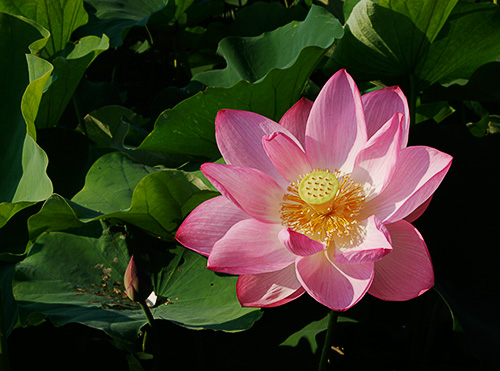
Lotus Blossom I (c) 2007 Patty Hankins
The lotus blossoms at Kenilworth Aquatic Gardens are worth a visit. The National Park Service staff is wonderful, always friendly and willing to provide information. Even when the gardens are crowded, we’ve never had any problems using a tripod in the park. I’ll definitely make a few more trips to photograph the lotus blossoms this month, in addition to trips later in the year for the water lilies.
by hankinslawrenceimages | May 26, 2008 | Washington DC
Memorial Day honors all those who have given their lives protecting our country. We’d like to thank all those who have served our country for their service, especially those who gave their lives for our freedom.

Marine Memorial (c) 2004 Patty Hankins
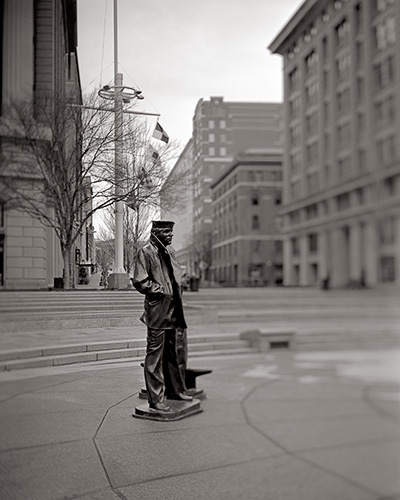
Lone Sailor (c) 2008 William Lawrence

Air Force Memorial (c) 2007 Patty Hankins

Women in Military Service for America Memorial (c) 2008 William Lawrence
by hankinslawrenceimages | May 24, 2008 | Photo Locations, Washington DC
The Vietnam Veterans Memorial in Washington DC is one of the most frequently visited memorials in the city. It honors all the men and women who served in the Vietnam War.
The Memorial is located in Constitution Gardens near the National Mall in Washington, DC. The closest memorial to is it the Lincoln Memorial. The Vietnam Veterans Memorial was authorized by Congress in 1980. Two years later, on November 13, 1982, the Memorial was dedicated.
The original section of the Memorial is the Memorial Wall, designed by Maya Ying Lin. The wall itself is 75 meters long. Engraved on the wall are the names of the over 58,000 men and women killed or listed as missing in action in the war. The WALL-USA website lists the names and information about all those listed on the Memorial Wall. There is also on interactive version of the wall online at Interactive Vietnam Veterans Memorial.

Flags at the Wall(c) 2004 Patty Hankins

The Wall at Dawn (c) 2005 William Lawrence
In 1984, the Three Servicement statue by Frederick Hart was added to the Vietnam Veterans Memorial.
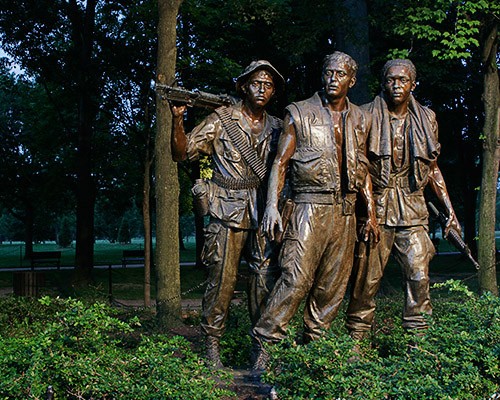
Three Servicemen Statue – Vietnam Veterans Memorial (c) 2005 Patty Hankins
On November 11, 1993, the Vietnam Women’s Memorial was dedicated. This statue by Glenna Goodacre honors all the women who served in the Vietnam War.

Vietnam Women’s Memorial (c) 2005 Patty Hankins
The Vietnam Veterans Memorial is located in Constitution Gardens near the Lincoln Memorial. The best way to see the Memorial is to take the Metro to the Smithsonian Station on the Orange and Blue Lines – and walk over to the Memorial from there. The only parking available near the Memorial is reserved for people with handicapped decals. Everyone else has to hunt for parking on the streets of DC. The Vietnam Veterans Memorial is open 24 hours a day. There is no fee charged to visit the Memorial.
We’ve been to the Vietnam Veterans Memorial several times either late at night or early in the morning. So far, we’ve never had any problems using a tripod. The Vietnam Veterans Memorial tends to get crowded during the day and sometimes in the early evening, especially on weekends and on holidays. I wouldn’t recommend trying to use a tripod if there are very many people at the Memorial – the paths are narrow so your tripod could easily affect other people’s ability to enjoy their visit.
by hankinslawrenceimages | May 22, 2008 | Photo Locations, Washington DC
The Korean War Veterans Memorial is one of the most striking – and least known – memorials in the Washington DC area. Bill and I are always amazed at how many people living in the DC area aren’t familiar with this memorial.
Located on the National Mall, the Korean War Veterans Memorial honors all those who fought during the Korean War in the early 1950s. The central part of the memorial is 19 sculptures of service men representing a squad on patrol, with members from each of the US military’s armed services. The metal sculptures were Frank Gaylord.

Korean War Veterans Memorial (c) 2005 Patty Hankins
The memorial also contains granite walls with photographic images sandblasted into them – and a wall with the words Freedom is Not Free.

Freedom is Not Free (c) 2005 William Lawrence
The final parts of the memorial include a Pool of Remembrance and a United Nations wall.
The Korean War Veterans Memorial was authorized by Congress in 1986 and dedicated on July 27, 1995 (the 42nd anniversary of the armistice ending the war).
The Memorial is located on the National Mall – between the Washington Monument and the Lincoln Memorial, on the other side of the Reflecting Pool from the Vietnam Veterans Memorial. It is administered by the National Park Service as part of the National Mall and Monuments Park. The best way to see the Memorial is to take the Metro to the Smithsonian Station on the Orange and Blue Lines – and walk over to the Memorial from there. The only parking available near the Memorial is reserved for people with handicapped decals. Everyone else has to hunt for parking on the streets of DC. The Korean War Veterans Memorial is open 24 hours a day. There is no fee charged to visit the Memorial.
The last time we tried to photograph the Korean War Veterans Memorial, we were told we could not use a tripod. This was at 5:30 in the morning – and the only people in site were Bill and I, and the security officer telling us we couldn’t use the tripods.
by hankinslawrenceimages | May 20, 2008 | Photo Locations, Washington DC
The World War II Memorial is one of the newer memorials in Washington, DC. Dedicated in 2004, the memorial honors all those who served in the US military during World War II and all those who supported the war effort on the home front.
Designed by Freidrich St. Florian, the memorial consists of 56 pillars, 2 arches, a plaza, a pool with fountains and a wall of stars – each of which represents 100 Americans killed during the war. Construction on the memorial began in September 2001, and was completed in the spring of 2004.
Here are some of our favorite photographs of the World War II Memorial:

World War II Memorial – Atlantic Arch (c) 2004 William Lawrence
Bill took this photo before dawn one morning – this was when we discovered that while the pillars are nicely it, the Atlantic and Pacific Arches aren’t lit at night.

World War II Memorial – Atlantic Arch Reflections (c) 2005 William Lawrence
Bill stood along the side of Reflecting Pool to take this photograph of the Atlantic Arch just as the sun was rising. The Old Post Office can be seen in the distance.

World War II Memorial – Pacific Arch (c) 2005 William Lawrence
This photograph of the Pacific Arch shows not only the arch, but the bronze eagle and wreath sculpture by Raymond Kaskey.

Kilroy Was Here (c) 2005 Patty Hankins
In tribute to the famous World War II cartoon graffiti Kilroy was Here – this graphic image is carved in at least two places on the World War II Memorial.
The World War II Memorial is located on the National Mall in Washington, DC, between the Washington Monument and the Lincoln Memorial. The best way to see the Memorial is to take the Metro to the Smithsonian Station on the Orange and Blue Lines – and walk over to the Memorial from there. The only parking available near the Memorial is reserved for people with handicapped decals. Everyone else has to hunt for parking on the streets of DC. The World War II Memorial is open 24 hours a day. There is no fee charged to visit the Memorial.
So far – we haven’t had any problems using a tripod at the World War II Memorial. If you visit during the day – you are more likely to find the Memorial to be crowded and encounter problems using a tripod.
by hankinslawrenceimages | Apr 28, 2008 | Photo Locations, Washington DC
The National Law Enforcement Officers Memorial in Washington, DC is one of the newer memorials in the City. It was authorized by Congress in 1984, and dedicated in 1991.
Located at Judiciary Square, the Memorial honors all law enforcement officers who have died in the line of duty. The names of the fallen officers are engraved on granite walls contained in the memorial. New names are added to the Memorial during a candlelight vigil during National Police Week in May. In 2008, National Police Week is May 11 – 17.
In addition to the walls with the names of fallen officers, the Law Enforcement Officer Memorial includes a reflecting pool and several lion statues sculpted in bronze by Raymond Kasky.
Here are photos of some of the statues. They were taken on a cold winter morning in January 2008.
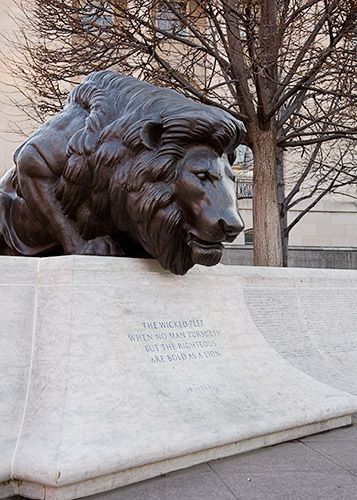
National Law Enforcement Officers Memorial I (c) 2008 Patty Hankins
The quotation from Proverbs 28:1 beneath the sculpture reads The Wicked Flee When No Man Pursueth But the Righteous Are Bold As A Lion
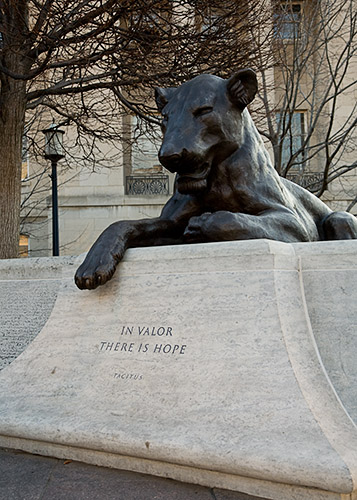
National Law Enforcement Officers Memorial II (c) 2008 Patty Hankins
The quotation by Tacitus beneath the lioness reads In Valor There is Hope
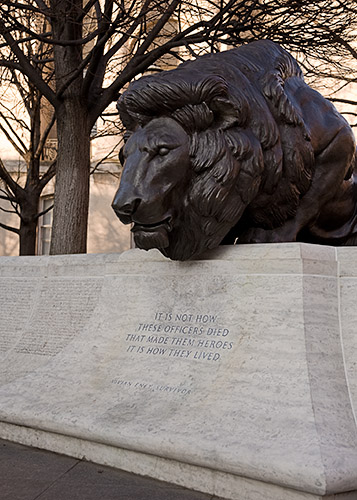
National Law Enforcement Officers Memorial III (c) 2008 Patty Hankins
The quotation beneath this sculpture reads It Is Not How These Officers Died That Made Them Heroes It Is How They Lived is by Vivan Eny, Survivor.
The National Law Enforcement Officer Memorial is located at Judiciary Square (between 4th and 5th Streets NW and D and F Streets, NW) in Washington, DC. There is limited street parking in the area. The easiest way to see the Memorial is to take the DC Metro’s Red Line to the Judiciary Square Station.
If you’ve never seen the National Law Enforcement Officers Memorial in Washington, DC, it’s definitely worth a visit.






















